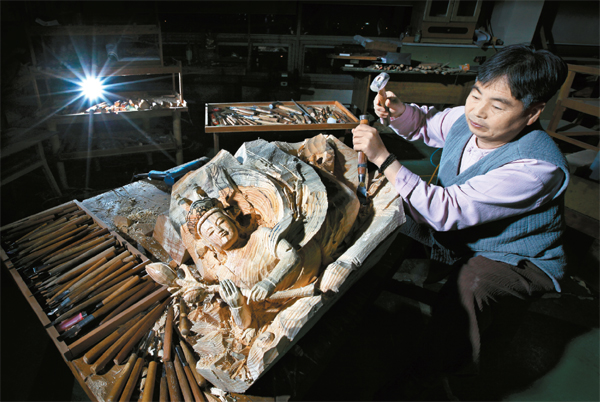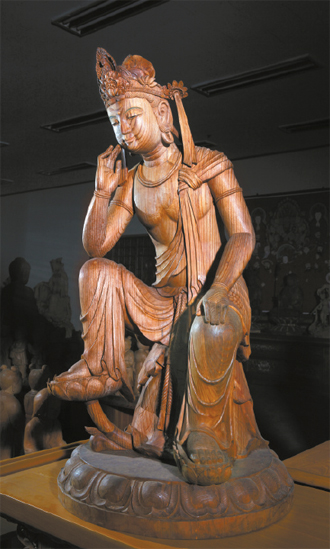Finding sacred images in the wood of Korea

The bulmo, or Buddhist artist, Heo Kil-yang carves a “Heavenly Maid” sculpture in his atelier in Paju, Gyeonggi. To create Buddhist sculptures, he goes through an elaborate process, including cutting, trimming and chiseling.
Those who carve the statue of Buddha are called the bulmo, which literally means “the mother of Buddha.” The name came from comparing the strenuous process of carving a statue of Buddha to a mother giving birth to a baby.
This year, artist Heo Kil-yang celebrates his 46th year as a bulmo. Having devoted his entire life to creating Buddhist art, he is a quintessential figure in the Buddhist arts.
Heo’s life is inseparable from Buddhism. Born to a devout Buddhist mother in Suncheon, South Jeolla, he spent a year in Seonam Temple as child monk before starting elementary school. Surrounded by Buddha’s teachings, he naturally thought of entering the Buddhist world; but, instead of becoming a monk, he discovered his true talent: carving.

Inspired by “Maitreya in Meditation,” Heo created this wooden Avalokiteshvara statue.
Winning the prestigious award was a huge accomplishment for the 24-year-old. But despite receiving so much praise, Heo still felt a thirst for Buddha’s teachings. That’s when he approached the monk Woo-il (1910-99), one of the most celebrated Buddhist artists in Korea, who taught him about Buddhist artists of the Joseon Dynasty (1392-1910).
Art critics consider Heo to be almost the only artist today who can depict the principles of traditional Buddhist art in Korea.
How then did Joseon’s Buddhist artists create their statues?
“Only the right kind of wood can be turned into Buddha’s body,” said the 61-year-old artist.
This involves more than selecting the type of wood; after choosing the material, the bulmo should go through a series of rituals to get rid of the wood’s evil spirits.
“You would need to spread out red clay, then a bronze mirror and a Buddhist flag should be placed nearby. Before cutting the tree down, religious rituals for mountain and tree spirits should also be held,” he said.
Upon completing the rituals, the sculptor starts to carve the wood. Once it takes shape, he soaks the wood in a herbal bath for a day, and after drying it, he covers it in a special lacquer. Only after countless brush strokes of lacquer is the statue covered with gold leaf. The bulmo’s job finally done, and monks can then begin the enshrinement ritual.

Left: The “Heavenly Maid” statue was inspired by the “Sacred Bell of King Seongdeok” from the Unified Silla era (668-935), but infuses Heo Kil-yang’s unique imaginative elements. Right: Heo smiles in front of the “Thousand Hands Thousand Eyes Avalokiteshvara” sculpture.
With more than 1,000 works to his name, Heo’s statutes can be found all over Korea.
To art critics, Heo’s works reflect not only an in-depth understanding of Buddhist doctrine, but also a unique artistic taste.
“I wish to blend the traditional Korean Buddhist art style into today’s culture, so that Korea’s younger generation can also cherish and preserve the Buddhist arts,” Heo said.
Looking at Heo’s collection, it seems like just a matter of time before his works will be added to the cultural assets of 21st-century Korea.
By Park Sang-moon, [moonpark@joongang.co.kr]










with the Korea JoongAng Daily
To write comments, please log in to one of the accounts.
Standards Board Policy (0/250자)